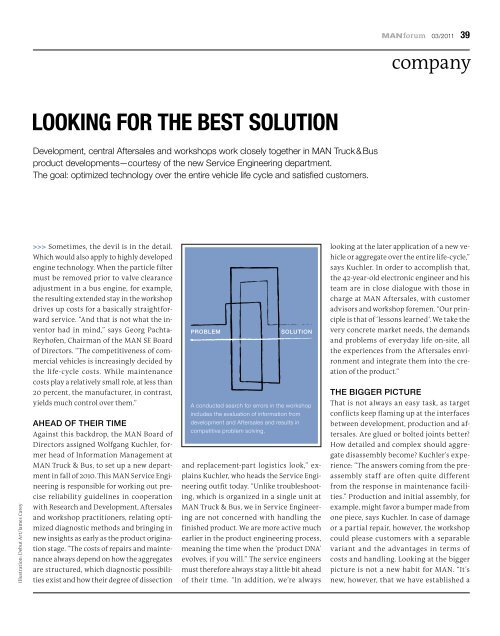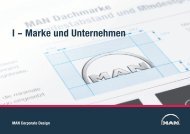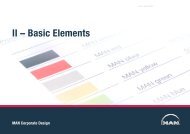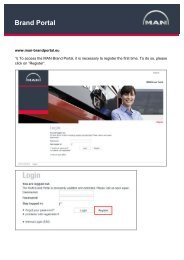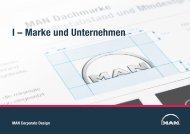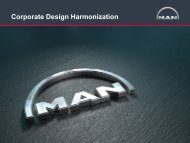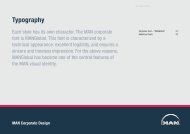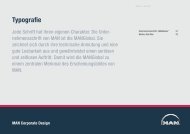You also want an ePaper? Increase the reach of your titles
YUMPU automatically turns print PDFs into web optimized ePapers that Google loves.
Illustration: Debut Art/James Carey<br />
Looking for the best soLution<br />
Development, central Aftersales and workshops work closely together in <strong>MAN</strong> Truck & Bus<br />
product developments—courtesy of the new Service Engineering department.<br />
The goal: optimized technology over the entire vehicle life cycle and satisfied customers.<br />
>>> Sometimes, the devil is in the detail.<br />
Which would also apply to highly developed<br />
engine technology. When the particle filter<br />
must be removed prior to valve clearance<br />
adjustment in a bus engine, for example,<br />
the resulting extended stay in the workshop<br />
drives up costs for a basically straightforward<br />
service. “And that is not what the inventor<br />
had in mind,” says Georg Pachta-<br />
Reyhofen, Chairman of the <strong>MAN</strong> SE Board<br />
of Directors. “The competitiveness of commercial<br />
vehicles is increasingly decided by<br />
the life-cycle costs. While maintenance<br />
costs play a relatively small role, at less than<br />
20 percent, the manufacturer, in contrast,<br />
yields much control over them.”<br />
AheAd of Their Time<br />
Against this backdrop, the <strong>MAN</strong> Board of<br />
Directors assigned Wolfgang Kuchler, former<br />
head of Information Management at<br />
<strong>MAN</strong> Truck & Bus, to set up a new department<br />
in fall of 2010. This <strong>MAN</strong> Service Engineering<br />
is responsible for working out precise<br />
reliability guidelines in cooperation<br />
with Research and Development, Aftersales<br />
and workshop practitioners, relating optimized<br />
diagnostic methods and bringing in<br />
new insights as early as the product origination<br />
stage. “The costs of repairs and maintenance<br />
always depend on how the aggregates<br />
are structured, which diagnostic possibilities<br />
exist and how their degree of dissection<br />
ProBLem SoLuTioN<br />
A conducted search for errors in the workshop<br />
includes the evaluation of information from<br />
development and Aftersales and results in<br />
competitive problem solving.<br />
and replacement-part logistics look,” explains<br />
Kuchler, who heads the Service Engineering<br />
outfit today. “Unlike troubleshooting,<br />
which is organized in a single unit at<br />
<strong>MAN</strong> Truck & Bus, we in Service Engineering<br />
are not concerned with handling the<br />
finished product. We are more active much<br />
earlier in the product engineering process,<br />
meaning the time when the ‘product DNA’<br />
evolves, if you will.” The service engineers<br />
must therefore always stay a little bit ahead<br />
of their time. “In addition, we’re always<br />
<strong>foru</strong>m 03/2011 39<br />
company<br />
looking at the later application of a new vehicle<br />
or aggregate over the entire life-cycle,”<br />
says Kuchler. In order to accomplish that,<br />
the 42-year-old electronic engineer and his<br />
team are in close dialogue with those in<br />
charge at <strong>MAN</strong> Aftersales, with customer<br />
advisors and workshop foremen. “Our principle<br />
is that of ‘lessons learned‘. We take the<br />
very concrete market needs, the demands<br />
and problems of everyday life on-site, all<br />
the experiences from the Aftersales environment<br />
and integrate them into the creation<br />
of the product.”<br />
The Bigger PicTure<br />
That is not always an easy task, as target<br />
conflicts keep flaming up at the interfaces<br />
between development, production and aftersales.<br />
Are glued or bolted joints better?<br />
How detailed and complex should aggregate<br />
disassembly become? Kuchler’s experience:<br />
“The answers coming from the preassembly<br />
staff are often quite different<br />
from the response in maintenance facilities.”<br />
Production and initial assembly, for<br />
example, might favor a bumper made from<br />
one piece, says Kuchler. In case of damage<br />
or a partial repair, however, the workshop<br />
could please customers with a separable<br />
variant and the advantages in terms of<br />
costs and handling. Looking at the bigger<br />
picture is not a new habit for <strong>MAN</strong>. “It’s<br />
new, however, that we have established a


